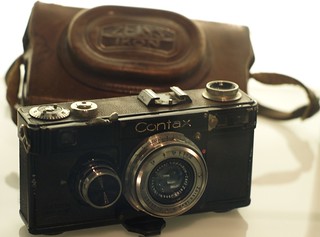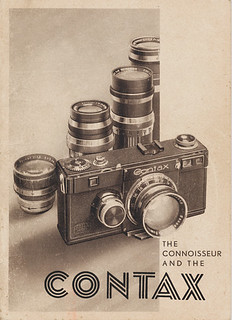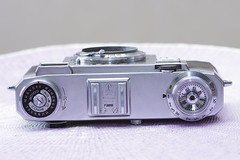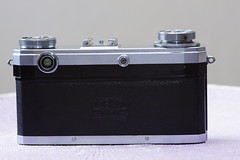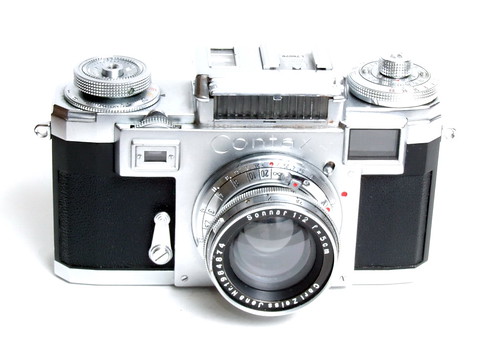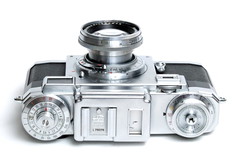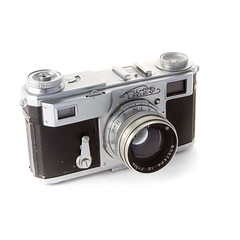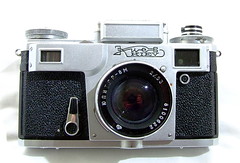Difference between revisions of "Contax rangefinder"
m (→The Contax Lens Mount: typos) |
m (link to Nikon RF lenses as derivative of the Contax RF mount) |
||
| Line 35: | Line 35: | ||
While revolutionary at the time mounting lenses is complex, for today standards, and requires patience and care. Both the camera body helicoid and lens must be set to infinity before mounting them on or off the camera. | While revolutionary at the time mounting lenses is complex, for today standards, and requires patience and care. Both the camera body helicoid and lens must be set to infinity before mounting them on or off the camera. | ||
| − | In the 1950s Nikon adapted this mount for their line of RF cameras. | + | In the 1950s Nikon adapted this mount for their line of [[Nikon_rangefinder_lenses|RF cameras and lenses. ]] |
In 2002, Cosina built a modern camera that used the same mount as a tribute to the Contax, under the '''Voigtlander Bessa R2C''' name. | In 2002, Cosina built a modern camera that used the same mount as a tribute to the Contax, under the '''Voigtlander Bessa R2C''' name. | ||
{{br}} | {{br}} | ||
Revision as of 14:02, 6 January 2022
Contax are a range of cameras made by Zeiss Ikon with a proprietary bayonet mount. The first rangefinder camera was launched in 1932 as a response to Leica rangefinder camera but aimed at professionals and journalists who needed a reliable and precise instrument. It was accompanied by a good variety of lenses and accessories to have a complete system of photography.

|
| Zeiss Ikon rangefinders Contax I, Contax II, and Tenax image by Michael Khan (Image rights) |
The 1932 camera had a large share of problems and was superseded by the Contax II in 1936 which is one of the most important cameras in history. After WWII the rebuilt Zeiss Ikon relaunched the camera name with modifications which were produced until 1961. The camera saw life for a longer time under the brand Kiev after the Zeiss Ikon factory was moved from Dresden to Ukraine as part of war reparations. It was produced in large numbers until 1986 and sold all over the world.
Contents
The Contax Lens Mount
Contax launched this mount which is coupled with the rangefinder and is shown in the same viewfinder window, which was great advance at the time.

|
| Contax II mount image by phollectormo (Image rights) |
The mechanism is complex and is in fact the combination of two bayonets.
- Internal bayonet: There is a focusing helical built in the body and the standard lenses mount directly in that focusing ramp via an internal bayonet. Standard lenses could be more compact and didn't need a focusing ring.
Lenses in the internal bayonet rotate with the focusing helicoid and thus the distance scale is engraved in the helicoid.
A small wheel is used to focus the camera and a infinity stop tab is added for storage and lens changing - External bayonet: Wide angles and teleobjectives mount on an external bayonet and have their own focusing ring. Rangefinder coupling is done via the body's focusing mechanism and overrides the focusing wheel used in the internal bayonet.
While revolutionary at the time mounting lenses is complex, for today standards, and requires patience and care. Both the camera body helicoid and lens must be set to infinity before mounting them on or off the camera.
In the 1950s Nikon adapted this mount for their line of RF cameras and lenses.
In 2002, Cosina built a modern camera that used the same mount as a tribute to the Contax, under the Voigtlander Bessa R2C name.
The 1930s cameras
| ||||||
|
|
Contax I
The Contax I is a high end 35mm rangefinder camera made by Zeiss Ikon to compete with Leica models. It was released in 1932. The Super Nettel was based on the Contax I, with the same kind of shutter, but a folding body, a fixed lens and a short based rangefinder. It was intended to be a cheaper alternative.
The Contax I was Zeiss' answer to Leica's offerings in the 35mm market, one Leica effectively controlled since it helped create it in 1925. It could be argued that the concpet is technically superior to the Leica, but let down by being rushed to the market, Zeiss being eager to catch up. The Contax has a number of technological advantages over the Leica. It has a longer rangefinder triangulation base (90mm) for better focusing, and the viewfinder and rangefinder were combined into 1 window. It has a bayonet lens mount (see Contax rangefinder lenses) instead of Leica's screw mount. It also has a removable back for loading film instead of Leica's bottom-loading system. To go up against Leica's horizontal-travel fabric shutter (maximum speed 1/500 second), the Contax has a vertical-travel articulated metal shutter (max. speed 1/1000); this is less vulnerable to sun burn as well.
However, the Contax I lacks in fit-and-finish: it is heavy and boxy with sharp corners, and suffers from many reliability problems.
From its introduction in 1932 until 1936, when the Contax II was introduced, the Contax I was a work in progress. There are no fewer than six iterations based on external features only. However many more variations exist, due to many non-visible internal changes such as the location and physical layout of how the angular displacement of the lens couples to the rangefinder system. Other changes were meant to make the rangefinder system stay within specifications better. Later versions actually provide better focusing feedback to the user, improved shutter reliability and control layout. These were not small changes, and many of the still-working models are actually later revisions. The lessons learned were incorporated in the Contax II, which became the cornerstone of design for rangefinders and was a much more reliable camera that went through fewer versions.
Contax II
After all the woes of the Contax I, Zeiss assembled a team lead by a chief designer, Hubert Nerwin, to have a more focused effort and to create a high quality product. The Contax II was released in 1936.

|
| Contax II image by phollectormo (Image rights) |
The Contax II is among the most well-known 35mm cameras ever made. It is difficult to overstate the level of quality that Zeiss achieved with the Contax II, and equally as difficult to overstate its pivotal role in the future development of all 35mm cameras that followed. At the time of its introduction, the Contax II had only one peer in the world that would be considered of the same importance: the Leica III.
The standard of quality achieved by Zeiss extended from the fit and finish of the camera to the unsurpassed imaging capability of the lenses and system equipment available. Many photographers consider the 50mm f/1.5 Sonnar lens to be among the greatest lenses ever made. The Contax II was widely used by photojournalists and other professional photographers throughout the 1940s and 1950s, and continues to have a strong following to this day. Variants and derivatives of the Contax II were made by other companies up until the late 1980s (see below).
The shutter system of the Contax II was completely changed from the Contax I, eliminating much of the notorious unreliability of the earlier camera. The Contax II was the first camera to incorporate a rangefinder focusing system into the same viewfinder that was used to compose the photograph (earlier built-in rangefinders such as was used on the contemporary Leica required the photographer to first focus with the rangefinder and then switch to a separate viewfinder to compose the photo). The broad rangefinder base (distance between rangefinder windows) of 90mm allowed more accurate focusing than other contemporary cameras. The Contax II famously included a top shutter speed of 1/1250th of a second, besting the rival Leica’s top speed of 1/500th of a second, and being one of the first cameras to achieve a top shutter speed above 1/1000th of a second.

|
| Contax II with lens collapsed image by Rick Oleson (Image rights) |
Like the Leica, the Contax system equipment range was extensive and grew to include a wide array of available lenses, many specialized accessories, and equipment developed for specific industrial, scientific, medical, and commercial purposes.
Together with the rival Leica III, the Contax II set the standard for all rangefinder cameras to follow, including the first rangefinders from Canon and Nikon, as well as later developments of the continuing line of fine Leica rangefinder cameras.
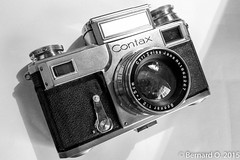
|
| Contax III (1936) image by Bernard O. (Image rights) |
The Contax III, also released in 1936, is a Contax II with an exposure meter. It was one of the first cameras with a built-in exposure meter.
Other cameras that influenced the Contax II are:
- The Nettax was meant to be a cheaper alternative; it was a derivative of the Super Nettel with a rigid body and interchangeable lenses with a specific bayonet and a very limited range of lenses.
- The Contaflex was a derivative of the Contax I. It is a 35mm twin-lens reflex with the same kind of shutter and a built-in exposure meter. It was an extremely expensive camera, that tested some of the features that would later appear on the Contax II and III. It has interchangeable lenses with a specific lens mount.
West-German relaunch by Zeiss-Ikon AG
After the war, the Western part of the Zeiss Ikon company based in Stuttgart made a complete redesign of the Contax cameras and launched the Contax IIa in 1950 and Contax IIIa in 1951. These cameras maintain the high quality fit and finish of the pre-war models and saw a few iterations as systems were improved.
|
| ||||
| |||||
| Contax IIa | |||||
|
| ||||
| |||||
| Contax IIIa (Carl Zeiss Jena lens from pre-war camera) | |||||
These cameras had several improvements over the pre-war models:
- Smaller body: A II body weighs 21oz (610g) and measures 3 3/8"x 1 11/16"x 5 1/2" (85.7x42.9x140mm) while a IIa body weighs 18oz (520g) and measures 3 1/16"x 1 11/16" x 5 5/16" (77.8x49.9x135mm). Side by side, a IIa looks about 20% smaller than a II, though the weight difference is only 3oz (90g).
- Improved Shutter: the cloth connecting straps of the II / III shutter curtains were replaced with gears. Painted Aluminum slats replaced the brass shutter slats of the II / III.
- The IIa / IIIa shutter sequence is T, B, 1, 2, 5, 10, 25, 50, 100, 250, 500, 1250.
From 1954, the speed dials were marked in different colors, and are called Color-dial Contax. - The use of Al changed the reliability and sound of the shutter, but also the slats needed to be thicker and that made the post-war Contax incompatible with the pre-war Biogon 35/2.8 as the rear element would touch the shutter blades and damage the rear element of the lens.
- The IIa / IIIa shutter sequence is T, B, 1, 2, 5, 10, 25, 50, 100, 250, 500, 1250.
- Flash Sync added: 1/25 s.
- Black dial cameras use a proprietary flash cable, which was replaced for a more standardized cable in the Color dial cameras.
- Shutter speed dial moved from the advance knob to a concentric to the advance knob. While the II / III could change shutter speeds whether the shutter was wound or released, it could not change speeds if the shutter was only partially wound, which the IIa / IIIa can.
- Manually set film counter moved from back of top plate to top of film advance
- Rangefinder length reduced from 90mm to 73mm
- Viewfinder made 1mm longer and wider than II / III, giving the user a larger image
The Contax IIIa, like the III included a bulky uncoupled selenium lightmeter.
These cameras were made until 1961 when Zeiss gave up on rangefinders to concentrate in the Contarex system.
The Kiev rangefinders
After the war, the Soviet Union captured the tooling and drawings of the Zeiss factories as war reparations, and transferred them to the city of Kiev, where they began the production of the Kiev rangefinder cameras in the Zavod Arsenal (Завод Арсенал ) factory. These cameras were basically copies of the Contax II and III and stayed in production until 1987, making this arguably a continuation of the Contax production for over 50 years.
The first models were made form German parts and were called Kiev 2 (unmetered), and Kiev 3 (metered) models. Further refinements such as flash-synchronization were introduced in the Kiev IIa and IIIa. Later the Kiev 4 (metered) and 4A (unmetered) were produced, with a final model called Kiev 4AM/4M.
Contax bayonet lenses were also made in the USSR using the original Zeiss designs and sold as Jupiter or Helios brands.
These cameras were sold worldwide in large numbers (over 1 million) and are found easily.
|
|
|
Bibliography
- Barringer, C. and Small, M. Zeiss Compendium East and West — 1940–1972. Small Dole, UK: Hove Books, 1999 (2nd edition). ISBN 1-874707-24-3.
- Dechert, Peter. The Contax Connection. Historical Camera Publications, 2007. Available for download in PDF at Peter Dechert's Corner (archived)
Links
In English:
- Zeiss Ikon Contax Rangefinder Lens Information Guide
- Biography of Heinz Küppenbender, chief developer of the Contax at The Zeiss Historica Society
- Contax I and Contax II/III at Cameraquest
- Zeiss Ikon COntax IIa/IIIa at the Pacific Rim Camera Ziss Ikon pages
- Repair notes in Rick Oleson's website:
- Contax (II-III) shutter ribbons (also applies to Kiev 35mm rangefinder models)
- Contax IIa shutter CLA
- Make a takeup spool for your Contax or Kiev (by Henry Fisher)
- Zeiss Ikon, Contax & Carl Zeiss lens Collectors FaceBook page
- Contax II listed at number 16 in Jason Schneider's Top 20 Cameras Of All-Time on Shutterbug.
In French:
- Lionel's Zeiss Ikon Contax II overview at 35mm-compact.com
- Zeiss page at www.collection-appareils.com by Sylvain Halgand
In Japanese:
- Archiv Zeiss / Exakta by Mori Ryōsuke (with some English)
| Zeiss Ikon Classic Cameras |
|---|
| Contax | Contaflex (TLR) | Super Nettel | Nettax | Tenax II | Tenax I | Ikoflex | Super Ikonta
Contax S | Contaflex (SLR) | Contarex | Icarex | SL706 |
